
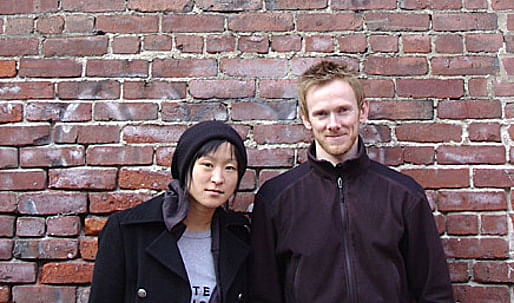
Working out of the Box is a series of features presenting architects who have applied their architecture backgrounds to alternative career paths.
Are you an architect working out of the box? Do you know of someone that has changed careers and has an interesting story to share? If you would like to suggest an (ex-)architect, please send us a message.
Archinect: Where did you study architecture?
Matt Trimble: Grad ___ MIT (M.Arch), Undergrad ___ The University of Memphis (BFA)
Garett Hwang: I received an M.Arch from MIT.
At what point in your life did you decide to pursue architecture?
GH: It must have been toward the end of undergrad. I was studying visual arts at Brown when a professor I greatly admired suggested it to me. After reviewing my senior show, which consisted entirely of deconstructivist paintings and photographs of urban formalism, he turned to me, laughing, and said “have you ever considered architecture?”
MT: I think it was around the 5th or 6th grade, while in elementary school. My dad was a carpenter. He passed away when I was five but I'm sure he was a significant influence on my interest in architecture. Also, my brother Stephen is an architect, and he has also been influential in my appreciation for architecture.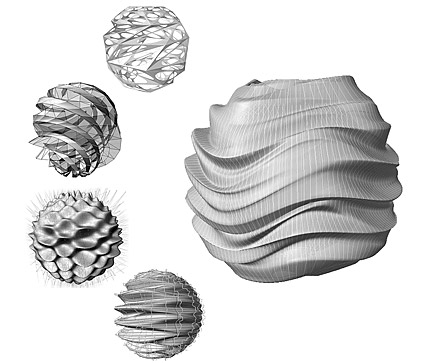
↑ Click image to enlarge
Adams Pendant: Design in development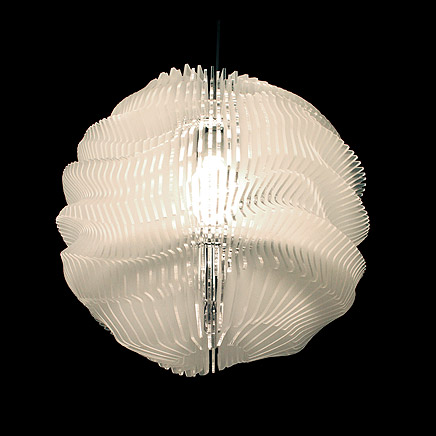
↑ Click image to enlarge
Adams Pendant: Final product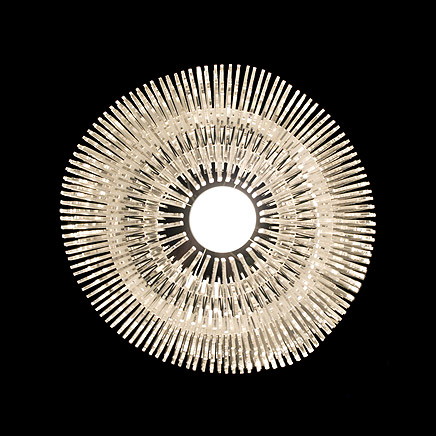
↑ Click image to enlarge
Adams Pendant: Final product (view from below)
When did you decide to stop pursuing architecture? Why?
MT: Toward the beginning of graduate school I began to realize that practicing architecture, exclusively, was not appropriate for me. For that reason, I have not been and am not on the path to becoming licensed. That said, I don't think I've stopped pursuing architecture, I've just found a way to apply the broad skill set that architecture school provides in a different way.
During the summer of 2001, I worked as an intern for Cunningham Architects in Dallas, TX. While I was there I was asked to make a series of small, repetitive changes to a construction set (about 60 separate AutoCad files). After about the 3rd or 4th file I thought, man, there's gotta be a way to automate this process. After some digging around online and tinkering with the software, I was able to write a really simple LISP (LISt Processing) script that automated each step: opening the file, modifying it, creating a plot file, saving the file, and closing it. We ran the script on a couple of other projects and then took the rest of the afternoon to play ping-pong. Yay! After that I continued working on little bits of process automation for other offices: Neil M. Denari Architects, Behnisch, and Preston Scott Cohen. I became intrigued with MIT when I discovered people finding interesting ways to incorporate scripting more directly into the design process. During my first semester, using tools like the laser cutter, 3d printer, and cnc router, it became apparent how the explicit, ruled-based worlds of computer numerically controlled machines could be explored using software and scripts. I was enthralled.
Stepping away from architecture, about midway through grad school, I helped start a product development/ industrial design company in Boston. Through that experience I began to see a range of potential commercial applications for 'design computing' (modeling, scripting, programming, animating, rendering). These applications included architecture, but were not limited to architecture.
↑ Click image to enlarge
Pro_Opt Programming Applet: Custom developed software applet for Shepley Bulfinch Richardson and Abbott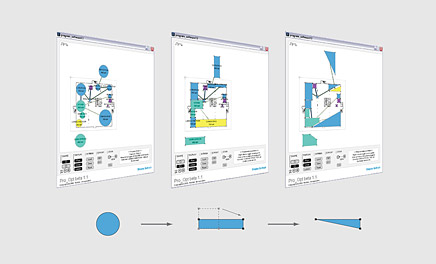
↑ Click image to enlarge
Pro_Opt Programming Applet: Custom developed software applet for Shepley Bulfinch Richardson and Abbott
↑ Click image to enlarge
Pro_Opt Programming Applet: Custom developed software applet for Shepley Bulfinch Richardson and Abbott
GH: I don't think I ever really left architecture. What we do now is merely an extension, or an expansion, of the field. I feel like what I learned through all my experiences in architecture school and out in the profession is that architecture incorporates such a wide range of possibilities and opportunities. Perhaps we don't build buildings, per se, but we process information and drive through similar stages in our design work. It's just another realm of architecture.
Describe your current profession.
Through Radlab, we work as consultants for architects, product designers, and entrepreneurs. In terms of type and scale we have recently completed work for the MIT Department of Mathematics, Berry Freeze, Myco, and are in discussion with the National Braille Press. For the MIT Math Department we were hired to redesign their headquarters. We recently finished revisions to the initially proposed schemes. Construction will hopefully begin in the spring of 2010. Berry Freeze, a new frozen yogurt shop that recently opened in Boston, hired us to design the shop's interior. Unexpected financial limitations made our proposal unrealizable. Nonetheless, they were a great client and we hope to work with them again in the future. We began working for Myco, the R&D arm of Mays and Schnapp Pain Clinic and Rehabilitation Center, in August 2008. We were hired to develop a new hand rehab device for patients suffering from Reflex Sympathetic Dystrophy. We just completed the production of the newest prototypes, which will be used for clinical trials. The National Braille Press has recently approached us with the desire to move to a more computationally sensible method, in terms of software and digital fabrication, for producing high volume tactile braille graphics. We're very excited about the opportunity.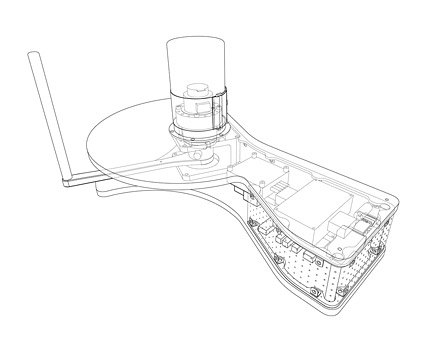
↑ Click image to enlarge
RSD Hand Rehabilitation Device: Wireframe
↑ Click image to enlarge
RSD Hand Rehabilitation Device: Most recent prototype (perspective)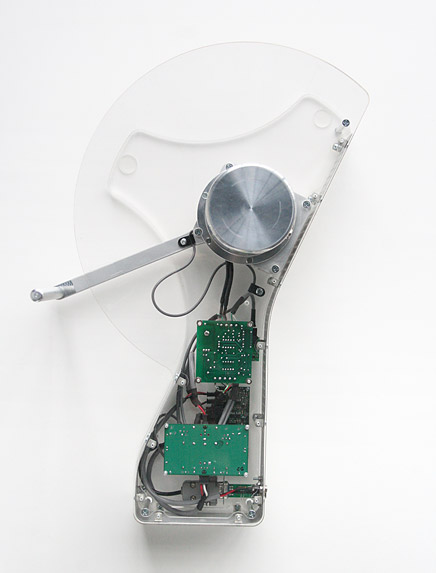
↑ Click image to enlarge
RSD Hand Rehabilitation Device: Most recent prototype (top view)
What skills did you gain from architecture school, or working in the architecture industry, that have contributed to your success in your current career?
GH: Through the study of architecture I learned a very systematic way of being creative, if that doesn't sound too contradictory. I tend to be very logical and process-oriented in working through ideas (consequence of years of programming), and the faculty and students at MIT really encouraged algorithmic design. The atmosphere of cross-disciplinary learning at MIT also really ingrained exploratory design methods, methods that strengthened our ability to apply design skills to a much broader range of problem types. Our projects at Radlab have ranged from scripting applets, modeling violin cases, designing CNC'd paneled ceiling systems, and prototyping medical devices.
MT: Architecture school played a huge part in helping me to gain specific skills. I learned to think more critically, to more systematically express ideas, to write algorithms (in common programming languages: VB script, C#, Java), to operate machines using computers ('rapid prototype'), and to be more considerate about how things are made.
Do you have an interest in returning to architecture?
MT: It's unlikely that I will return to a traditional path toward making architecture. Having said that, I hope to remain engaged with architects and architecture through practice and academia.
GH: I think I will always want to remain on the edge of the profession. I don't see myself ever wanting to be the typical architect who only designs buildings, unless it's to push the computational boundaries of design. But I really enjoy where we currently are: exploring the instances when architecture blends with other disciplines. Being exposed to new ideas and methods is an everyday occurrence; who wouldn't love that?
Creative Commons License
This work is licensed under a Creative Commons License .
/Creative Commons License
No Comments
Block this user
Are you sure you want to block this user and hide all related comments throughout the site?
Archinect
This is your first comment on Archinect. Your comment will be visible once approved.